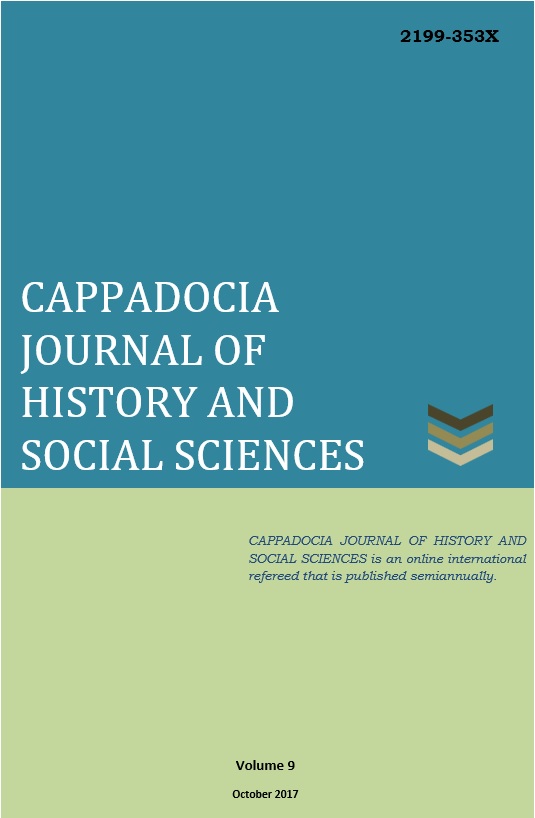SOSYAL BİLGİLER DERSİ TARİH ÜNİTELERİNİN ÖĞRETİMİNDE ÇİZGİ FİLMLERİN KULLANIMININ AKADEMİK BAŞARIYA ETKİSİ
Author :
Abstract
Bu araştırma, “Bu çalışma Sosyal Bilgiler dersi tarih ünitelerinin öğretiminde çizgi filmlerin kullanımının öğrencinin akademik başarısına etkisini tespit etmek amacıyla yapılmıştır. Bunun için 7. sınıf Sosyal Bilgiler programında yer alan “ Ülkeler Arası Köprüler”, ünitesi “Birinci Dünya Savaşı ve Çanakkale de Mustafa Kemal” konusu seçilmiş ve konuya uygun olan “Çanakkale Geçilmez” adlı çizgi film kullanılmıştır. Araştırma öntest-sontest kontrol gruplu deneysel desen (ÖSKD) modelinde tasarlanmıştır. Araştırma 2011–2012 öğretim yılı Niğde ili merkez ilçesi Cumhuriyet İlköğretim Okulu’nda, iki ayrı sınıfta 70 kişiden oluşan örneklem üzerinde öntest - sontest olarak gerçekleştirilmiştir. Konu deney grubuna çizgi film izletilerek, kontrol grubuna ise çizgi film izletilmeden geleneksel yöntemle yani düz anlatım metoduyla anlatılmıştır. Araştırmada başarıyı ölçmek adına, “Birinci Dünya Savaşı ve Çanakkale de Mustafa Kemal” konusu ile ilgili 20 sorudan oluşan dört seçenekli çoktan seçmeli başarı testi uygulanmıştır. Araştırmanın alt problemleri SPSS programı ile analiz edilmiştir. Analiz yorumlarında t testinden faydalanılmıştır. Analiz sonuçlarına göre sosyal bilgiler öğretiminde çizgi film izleterek ders işlemenin öğrencilerin akademik başarılarını artırmada etkili olduğu sonucuna ulaşılmıştır.
Keywords
Abstract
This study was carried out to determine the effect of the use of cartoons on academic achievement of students in the teaching of history units of social studies course. For this, the "Intercountry Bridges" in the 7th grade Social Studies program, the unit "World War I and Mustafa Kemal in Çanakkale" were chosen and the cartoon called "Çanakkale Geçilmez" was used. The research was designed in the pretest-posttest control group experimental design (ÖSKD) model. The research was carried out as a pre - test and post - test on the sample composed of 70 people in two separate classes in the primary school of the Niğde province in 2011-2012 academic year. The subject is shown in the experimental group, and in the control group, the cartoon is explained without a trace in the traditional way, ie by the straight narration method. In order to measure success in the research, a four-choice multiple-choice success test consisting of 20 questions related to "World War I and Mustafa Kemal in Çanakkale" was applied. Sub-problems of the study were analyzed by SPSS program. The t test was used for analysis comments. According to the results of the analysis, it has been reached that it is effective in increasing the academic achievement of the students by watching the cartoon in teaching social studies.
Keywords
- ALAN, İlkay (2009), “Sevgi İçerikli Çizgi Filmlerin İlköğretim 5. Sınıftaki Çocukların Görsel Sanatlar Dersinde Yaptıkları Resimler üzerindeki Etkisinin İncelenmesi’’, Yüksek Lisans Tezi, Gazi Üniversitesi Eğitim Bilimleri Enstitüsü, Ankara.
- BÜYÜKÖZTÜRK, Şener (2001), Deneysel Desenler, Ankara: PegemA Yayıncılık
- CAN, Aytekin (1996), Çocuk ve Çizgi Film, Konya: Özeğitim Yayınları.
- CAN, G., Yaşar, Ş. Ve Sözer, E. (1998) Sosyal Bilgiler Öğretimi, Eskişehir Üniversitesi Yayınları.
- DOĞANAY, Ahmet (2005), Sosyal Bilgiler Öğretimi,(Editörler:Cemil Öztürk-Dursun Dilek) Hayat Bilgisi ve Sosyal Bilgiler Öğretimi, Ankara: PegemA Yayıncılık.
- GÜLTEKİN, M. (1999). Temel eğitim ikinci kademe için alternatif program modelleri. Eskişehir, Anadolu Üniversitesi yayınları.
- HÜNERLİ, Selçuk (2005), “Canlandırma Sineması Üzerine”, İstanbul: Es Yayınları.
- ILGAZ, Sevil (1997), “Çizgi Film Temel İlkeleri Yapım Tekniği”, İstanbul: Leyla Yayıncılık.
- KABA, Fethi. (2002). “Türkiye’de Çizgi Film: Gelişimi ve Eğitimi”, Eskişehir: Anadolu Sanat, Anadolu Üniversitesi Güzel Sanatlar Fakültesi, Sayı:13.
- KABAPINAR, Y. ve BAYSAL, N. (2004) Hayat bilgisi ve Sosyal Bilgiler öğretimine yaşamın kendisini taşımak: Gazete haberinin kullanıldığı bir Öğretimin tasarlanması ve değerlendirilmesi, Eğitim Yönetimi.
- KARASAR, Niyazi (1999), Bilimsel Araştırma Yöntemi (9. Basım), Ankara: Nobel Yayın Dağıtım.
- KÖSTÜKLÜ, Nuri (2001), Sosyal Bilimler ve Tarih Öğretimi, Konya.
- KÜÇÜKAHMET, Leyla. (1997). Eğitim Bilimine Giriş, Ankara: Gazi Kitabevi Yayıncılık.
- ÖZAKÇAOĞLU, Nilüfer(2009), ‘’Çizgi Filmlerin Zihinsel Engelli Öğrencilerin Resimlerine Anlatım, Biçim Ve Renk Olarak Yansıması,’’ Yüksek Lisans Tezi, Gazi Üniversitesi Eğitim Bilimleri Enstitüsü Güzel Sanatlar Eğitimi Bölümü Resim İş Öğretmeliği Anabilim Dalı, Ankara.
- ÖZTAŞ, Sezai (2009), Sosyal Bilgiler Öğretiminde Filmlerin Kullanımı , (Ed. Safran, Mustafa ) Sosyal Bilgiler Öğretimi, Ankara: Pegem Akademi.
- ÖZTÜRK, C. DİLEK, D. (Ed.) (2004), Hayat Bilgisi ve Sosyal Bilgiler Öğretimi, Ankara, Pegem A Yayıncılık.
- ÖZTÜRK, C., Keskin, S ve Keskin, Y, (2004) İlköğretim Okulu 4. Ve 5. Sınıf Sosyal Bilgiler Derslerinde Materyal/Teknoloji Kullanım Durumu, M.Ü Atatürk Eğitim Fakültesi Dergisi, Sayı 19, Sayfa 107-120.
- SÖNMEZ, V. (1997) Sosyal Bilgiler öğretimi ve Öğretmen Kılavuzu, Ankara, Anı Yayıncılık.
- YAVUZER, Haluk. (1998). Çocuk Psikolojisi (16. Basım) İstanbul: Remzi Kitabevi.





